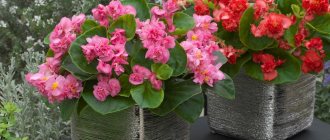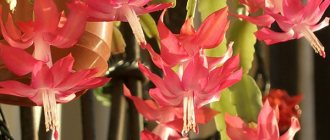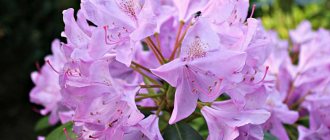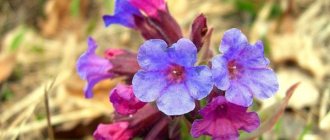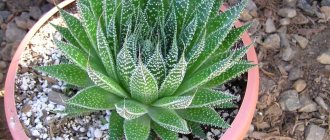Ornamental physalis is an original plant with bright orange fruit calyxes. Outwardly, they resemble Chinese rice paper lanterns. This is an unpretentious plant that is successfully used in landscape design. Thanks to the ease of care, growing physalis in your garden is not at all difficult.
Physalis - a bright decoration of the garden in autumn Source www.bloomingarden.ru
Features of the plant
Physalis is a herbaceous, fairly tall (up to 90 cm) plant with straight stems and oval, slightly tapering leaves. Among more than a hundred subspecies there are:
- edible;
- decorative, which are not intended for food.
Decorative varieties
The popularity of use in landscape design is associated with the spectacular appearance of orange-red boxes with a diameter of 60 mm with a round fruit inside. There can be up to 15 of these “lanterns” on each branch.
Of all the varieties for decorative purposes, the following varieties are most often planted:
- Physalis francheti;
- Physalis alkekengi and others.
Physalis francheti Source wikimedia.org
Lanterns left on branches for the winter become skeletonized under the influence of weather conditions. A bright berry is visible through numerous gaps in the network of veins. Decorative, spectacular branches can be used not only as a means of garden decoration, but also for interesting compositions of dried flowers, as well as crafts.
Important ! The fruits of ornamental plant varieties should not be eaten - they contain toxic substances.
Skeletonized box Source www.greenmarket.com.ua
Varieties that can be used for food
Edible varieties are divided into 2 groups:
- Vegetable.
- Berry.
Berry varieties of physalis include plants with small fruits:
- Pineapple;
- Strawberry;
- Magician;
- Columbus and others.
The annual vegetable has a good yield and has fairly large fruits - weighing up to 50 grams. The most popular varieties: Moscow early and Korolek.
Physalis vegetable Source semenaorg.ru
Only edible varieties have beneficial properties. They are rich in vitamins, proteins, microelements, carbohydrates and other substances. The berries are used raw and as decoctions for medicinal purposes.
For your information ! Berry varieties are heat-loving, while vegetable varieties are resistant to low temperatures.
Useful properties and contraindications
Composition, nutritional value, calorie content
Any physalis fruit, vegetable or berry, contains a lot of vitamins and microelements. A huge amount of vitamin C, vitamin A (14% of the daily dose required for the body), antioxidants and a unique composition of B vitamins make the plant indispensable in medical nutrition. In addition, physalis fruits are low in calories and can be used in diets for metabolic disorders accompanied by excess weight. Let's take a closer look at the benefits and harms this plant brings.
Beneficial features
To illustrate the beneficial properties of physalis, we can cite as an example the opinion of the famous folk healer Alexei.
- for stones in the kidneys and bladder - a decoction of the fruits orally;
- for gout and edema - decoction of fruits externally;
- for purulent inflammation - juice or infusion. You can use fresh berries;
- for pain in the stomach and intestines - fresh fruit puree;
- for dermatitis - physalis ointment (fruit ash mixed with vegetable oils).
Contraindications
There are no special contraindications to the use of Physalis. However, we must remember that, like any sour fruit, it can cause aggravation in patients with gastritis. Patients with pancreatic and gallbladder insufficiency also need to be careful. Diabetics should limit very sweet varieties in their menu.
Application area
As stated above, the scope of application is quite wide. You can use decoctions for flu, laryngitis, and lung diseases. Low-calorie desserts are good for dietary nutrition.
Traditional medicine recipes
Decoction
Place 30 g of dried fruits in 0.5 liters of water and cook for five minutes. Use the resulting dose for two days for kidney and bladder diseases.
Ointment
Burn dried fruits (100 g) over an open flame until ash is obtained. Grind and sift the ash. Mix with a small amount of olive oil until you obtain the consistency of an ointment. Use for healing wounds, cracks and dermatitis.
Choosing a location: how to create the best conditions
Physalis is not picky about where it grows, and can grow even in drafts, and tolerates even low temperatures. Since the decorative value of the plant lies in its lanterns, it is recommended to plant it in sunny areas. The approximate planting density is approximately 5 plants per area of 1 m².
Physalis capsules have not yet gained color Source www.jardin-adoue.com
It is advisable to choose neutral or calcareous soil. Not suitable - too wet acidified soils, as well as with close groundwater.
The soil must be prepared before planting. To do this, they add either complex mineral fertilizers or organic ones (ash, humus, compost).
When choosing a place on a personal plot, you need to take into account what garden crops were grown there before. If in previous years legumes, cabbage, cucumbers, potatoes, beets or carrots grew in the selected place, physalis will also feel good here.
For your information ! The plant cannot be planted in an area that was previously allocated for nightshade crops.
Research [edit | edit code]
The largest Russian scientific organization conducting active research and selection of physalis is VNIISSOK.
The All-Russian Institute of Plant Growing named after N. I. Vavilov has a collection of many species and varieties of physalis.
Decorative physalis, with its bright boxes of orange-red tones, is very reminiscent of Chinese lanterns and immediately creates a feeling of celebration. For this reason, he has quite a following. But those who did not take physalis also have their own arguments - the fruits of the plant are poisonous.
Rules for caring for ornamental plants
Decorative physalis, the cultivation and care of which is not very difficult, is often used to decorate personal plots. An adult plant is resistant to wind and drought. And it only needs watering when the weather has been dry for a long time. But newly planted physalis requires careful care.
Healthy plant Source plantscientists.com
Decorative physalis needs regular weeding, which should preferably be done at least once a month. This is due to the fact that weeds are able to “clog” the plant, which negatively affects its growth and attractiveness. You can avoid weeding by using mulching. The effect will be greater if the mulch layer is about 20-30 mm.
Fertilizers: when is the best time to apply them?
It is advisable to apply fertilizers twice a year:
- during a period of active growth;
- during the flowering period.
For these purposes, complex mineral fertilizers or humus are used. Another possible problem is the slope of the branches. If you want the stems to remain straight, they should be tied up.
Preparing for winter
The decorative qualities of physalis are the unusualness and originality of its boxes. It is important that they ripen before the onset of autumn cold weather. To do this, at the end of summer it is recommended to pinch the tops of the branches.
All the beauty of physalis Source www.ogorod.ru
For the winter, physalis is left in the ground. In autumn, the stems are cut and later used for home decoration. There is no special shelter for the plant, but it is advisable to mulch the area around it. For this purpose, fallen leaves and peat are used.
Physalis is frost-resistant, withstands frosts down to -30°C. In the spring, in the place where a beautiful bush grew last season, young shoots emerge. Over the course of a season, these “babies” recreate the plant. It can be transplanted to a new place in the spring or left in the same place and admire the bright physalis boxes in early autumn.
For your information ! Even if the above-ground part of the plant is not cut off before the cold weather, it will still die from exposure to low temperatures.
How to “keep” physalis in one place
If there is no need to expand the flower bed with physalis, then for several years (from 5 to 7) it can not be planted. Additionally, to prevent its spread, physalis can be surrounded by a border, or other improvised barriers can be used. In this case, the fence should be buried 0.2-0.3 m so that the roots do not spread to the new territory.
Once established, physalis grows quite quickly on the site. To keep this process under control, it is recommended to rejuvenate it every 5 years: divide the rhizomes and plant them in another place.
For your information ! The decorative quality of a plant directly depends on the quality of care.
The attractiveness of a mono composition Source www.ogorod.ru
general information
Physalis grows into a fairly large shrub thanks to its branching stems. The average height ranges from 60 to 120 cm. Moreover, in 1.5 months one such bush easily produces up to 150 small fruits.
Physalis is the largest genus in its Solanaceae family. In nature, it is more common in South and North America, but is already quite common in Asia and Europe. The name means “bubble” from Greek, which is easily explained by the shape of the fruit.
Among the physalis there are annuals and perennials. As they grow, the shoots become lignified, and the shrub resembles a real tree. During the flowering season, single flowers bloom along the entire length of the shoot, after which swollen spherical fruits with a characteristic aroma are formed.
In addition to its active use in cooking, physalis has many medicinal properties. And all thanks to the high content of beneficial acids and minerals. In folk medicine, even the leaves and roots of the plant are used to prepare decoctions.
Photo: pxhere.com
The use of physalis in interior design
Decorative physalis is used in landscape design of the site and as a dried flower. The plant gains decorative value when the lanterns acquire a bright orange-red color. At this stage, you can begin to prepare raw materials for future compositions.
Late autumn Source krrot.net
See also: Catalog of projects for garden houses made of kiln-dried timber
To do this, perform the following steps:
- Cut off the stems.
- Remove leaves.
- Dry for 2-3 weeks in the open air.
It is best to hang dry physalis. If the plant will be used in the form of a finished bouquet, you can tie the stems several pieces together and dry them in this form. If you need separate branches, then each stem must be hung separately.
Bright orange boxes are suitable for interior decoration Source picsart.com
For decoration, you can use not only physalis branches, but also single boxes. Wall wreaths are woven from it and used as part of New Year's compositions along with coniferous branches, craspedia, gomphrena, spikelets and other plants.
New Year's garland decor Source www.ivd.ru
Decorative wreath Source dekormyhome.ru
Composition using physalis Source www.hit-dekor.ru
Recipes
Before pickling, the fruits are washed under running water, damaged and wrinkled ones are selected. To make caviar and jam, you can use slightly overripe fruits.
Pickled Physalis
Before marinating, you need to prepare a sterilized glass container. Place on the bottom of the jars: two garlic cloves, a few black peppercorns, a bay leaf, a sprig of any garden herb, half a red chili pepper. Then the container is filled with physalis berries, placed tightly to each other. All ingredients are poured with boiling water. After 15 minutes, pour the water from the jars into a saucepan, add one teaspoon of salt and sugar to each jar. After the composition begins to boil, it is again poured into jars. Immediately close with airtight lids.
Sauce
This spicy sweet and sour gravy serves as an accompaniment to steaks. You will need: a cup of pineapple physalis, two sweet crumbly apples, juice of half a lemon, 30 ml of liquid honey, salt, pepper, several cilantro seeds. Apples need to be peeled, seeds removed, and finely chopped. Add crushed berries to them and simmer in mustard oil until brown. Then add seasonings and simmer for another 5-10 minutes under the lid. Then reduce the heat to minimum, add honey, pour in lemon juice, and simmer for 2-3 minutes.
Candied fruit
To prepare the dish, take strawberry varieties. For two kilograms of fruit, syrup is prepared from 2.5 kg of granulated sugar and 600 ml of water. Bring the mixture to a boil, pour in the berries. It is cooked for 10 minutes over low heat. After this, the mass rests for 5 hours. Then the procedure is repeated. After re-cooking, transfer the berries to a colander and allow the liquid to drain. The syrup can be used to make compote. The fruits are sprinkled with powdered sugar and dried in the oven at a temperature of 30-40 degrees for 2-3 hours.
Caviar
For one kilogram of physalis vegetable varieties, take 600 g of carrots, 300 g of onions. The root vegetables are grated, transferred to a deep frying pan, and fried in olive or camelina oil for 4-5 minutes. Physalis is blanched and the skin is removed. Then they are finely chopped or blended and added to vegetables. All ingredients are simmered together until soft. Towards the end of cooking, add salt, sugar and seasonings to taste.
Cocktail “Fruit Explosion”
You will need the following ingredients: strawberry physalis, mango, passion fruit, ice cream, fruit liqueur, ice. Fruits need to be peeled, seeds removed, and cut into pieces. Beat the slices in a blender along with the ice cream. The mixture is poured into a glass, a spoonful of liqueur is added, and stirred. Ice is placed on top and garnished with physalis berries.
The use of physalis in landscape design
Decorative varieties of physalis are used in landscape design in various compositions. From an aesthetic point of view, it is the cups with fruits that are attractive, not the flowers.
Most often, physalis is planted as an independent plant. It must be taken into account that it is better not to plant several varieties in one flower bed, since plants can interbreed. This often affects the decorative qualities of the bushes.
Site design Source rastenievod.com
It is difficult for physalis to find suitable “neighbors”. It is so unusual and bright that it will distract all attention to itself. Even stems with bolls left for the winter will serve as a bright decoration for a snow-covered garden.
Physalis looks good surrounded by low grasses that do not cover it and do not hide all the beauty and originality of the bright boxes with fruits. Very often it is used in containers placed in the garden or installed near the house, as well as in spacious flowerpots.
Growing a plant in a container Source allegroimg.com
The plant is suitable for growing even in those parts of the site that are not suitable for other crops. The green mass of its leaves is a good background for herbaceous, beautifully flowering perennials. But everything changes when the fruit pods on the physalis itself acquire a bright orange color. The main purpose of growing physalis on the site is to obtain material for creating decorative winter compositions in the house.
Important ! When working with a plant, it is necessary to take into account its toxicity.
The boxes gradually acquire an orange color Source lovely-dom.ru
Interesting Facts
In some countries, physalis is a symbol of love and desired pregnancy. In Europe, there is a beautiful custom of giving physalis. It is customary to present a bouquet of Chinese lanterns to a girl with whom a man wants to have a child. Branches with orange buds are also given to pregnant women - cups with berries hidden inside symbolize the fetus in the mother's womb. The wife's relatives can present such a bouquet to the future father as a sign of gratitude for the successful conception.
There is a Chinese legend about the origin of the physalis plant. In ancient times, an evil dragon swallowed the sun. Darkness reigned on Earth, people could not find each other, animals began to die. There was a brave soul who decided to return the sun to all living things. He took a lantern and went in search of the dragon. The young man wandered for a long time, and, finding an evil monster, killed him. The sun soared up, and the hero, blinded by its rays, dropped the lantern to the ground. As it fell, it turned into thousands of small lanterns that rolled across the ground and hung on the blades of grass.
There is a sign that a bouquet of physalis placed in the house drives away evil spirits and attracts prosperity and comfort. This beautiful plant fills you with positivity just by looking at its cheerful orange lanterns.
Diseases and pests: problems and solutions
Physalis is not susceptible to diseases and pest attacks when properly maintained. But this does not mean that a hundred problems will never arise.
Problem #1. Increased soil moisture
If the soil is too wet, rot appears on the stem. The solution to the problem is to transplant the physalis to a place suitable for the plant.
White rot Source rastenievod.com
See also: Catalog of companies that specialize in landscape design
Problem #2. Aphid
There is also a danger of damage to perennials by aphids. This can only happen under the right conditions:
- lack of watering during prolonged drought;
- proximity to plants that are already infected with aphids.
With such damage it is necessary to use insecticides. And as a preventative measure, water as needed.
Problem #3. Late blight
Belonging to the nightshade family, physalis can be affected by late blight. External manifestations are brown spots that appear on fruits and leaves.
As a rule, such a problem occurs due to the following factors:
- thickening;
- long rains.
Late blight Source hozyain.by
The solution to the problem is to act on the warning and prevent its occurrence. To do this, plants should be sprayed even before fruit sets.
Problem #4. Blackleg
External manifestation: blackening of the sprout stem at the base. With such damage, the plant dies.
The following circumstances may lead to this:
- high humidity;
- soil acidification;
- cold air.
To prevent the problem from affecting all seedlings, you must perform the following steps:
- Remove affected shoots from the soil.
- Loosen the soil.
- Treat the soil with fungicides.
Advice ! To prevent this problem from arising, it is necessary to promptly thin out the seedlings and loosen the soil to prevent it from souring.
Black leg completely kills the plant Source dacha.help
Problem #5. Mosaic
Mosaic is a viral disease quite rare for physalis. It is caused by bacterial damage. Externally, the mosaic is manifested by a change in the color of the leaves into dark and light areas.
Ways to solve the problem:
- Remove the plant along with the roots.
- Burn the affected plant.
- The soil in the area where the affected physalis grows must be treated with potassium permanganate.
For your information ! Improper crop rotation can lead to bacterial damage.
Problem #6. Wireworm
The wireworm damages the root system of the plant. This is facilitated by acidification of the soil and the spread of wheatgrass. Adding ash to the soil and controlling weeds will help cope with the problem. This will create an environment unfavorable for the development of wireworm larvae.
Orange wireworm Source zelenj.ru
Problem #7. Medvedka
The danger of a mole cricket attack is damage to the root system. To prevent damage to the plant, you can use the following techniques:
- Throughout the summer, it is necessary to carry out high-quality loosening of 0.15 m.
- Use plants nearby that have a specific aroma and repel mole crickets. Marigolds are suitable for this.
- Watering with a solution of bird droppings has no less effect.
Medvedka spoils the roots Source 7ogorod.ru
Help from Wikipedia
Physalis (lat. Physalis ) is the largest genus of plants in the Solanaceae family, often compared to tomatoes (Solanum lycopersicum). People call it emerald berry or earthen cranberry (although it has nothing to do with cranberries), as well as Jewish cherry.
The greatest species diversity is observed in Central and South America.
Physalis are perennial (much less often annual) herbaceous plants with a woody stem at the base.
A characteristic feature of all Physalis is the fruit-berry, enclosed in a shell-case made of fused sepals, similar to a Chinese paper lantern (hence the name of the genus: φυσαλίς in Greek means bubble). During the first time after flowering, the calyx grows noticeably faster than the fruit. When the fruit is fully ripe, the calyx dries out and its color changes.
Physalis are heat-loving plants; most practically do not tolerate frost, although there are exceptions.
In Russia, the most widely distributed wild plant is Physalis alkekengi L. - Physalis Alkekengi, or common physalis, or Franchet physalis, or Chinese lantern. This plant overwinters in temperate climates and grows annually from rhizomes. The fruits of this species are unsuitable for consumption due to their bitter taste.
Physalis ixocarpa Brot. is most often found in cultivation in Russia. - glutenous physalis, or vegetable physalis, or Mexican physalis, or Mexican tomato and Physalis pubescens L. - pubescent physalis, or strawberry physalis. Physalis peruviana L. - Peruvian physalis, is grown relatively rarely.
Physalis was brought to our country along with tomatoes and potatoes, but for some reason did not gain popularity. Inexplicable prejudices towards this wonderful plant among Russian gardeners, as well as towards amaranth, chard, broccoli, savoy cabbage, etc., hinder its spread.
In garden plots, two types of edible physalis are most often found - Mexican (vegetable) and berry (strawberry) pubescent physalis. In the southern regions you can find Peruvian physalis.
Physalis propagation: all methods
Physalis can be bred in several ways. The simplest, with a high probability of success, is the method of dividing the rhizome, and the most labor-intensive is growing from seeds.
Young sprouts Source rastenievod.com
Growing seedlings from seeds
The start time for work is April. Before sowing seeds, they must be prepared. First, tie it in gauze and dip it in a weak solution of potassium permanganate for half an hour. At the same time, prepare the soil mixture for the seeds.
You can do this in one of the following ways:
- Calcination in the oven.
- Hot steam treatment.
Physalis seeds Source 7dach.ru
After the earth has cooled, it is poured into prepared containers. The following actions are carried out with the seeds:
- Lay out on the surface.
- Pressed.
- Sprinkle 10 mm of soil on top.
- Watered.
- Cover with glass or cling film.
The containers are transferred to a well-lit place, in which the temperature should be maintained at 15-20ºC. After the sprouts have appeared, the glass is removed.
Advice ! Seeds can be planted immediately, if possible, in separate containers with substrate.
After two true leaves appear on the sprouts, a pick is made, mineral fertilizers are applied, and watered. In the future, watering and fertilizing should be regular:
- watering - as needed;
- fertilization - every 2 weeks.
Seeds in a ripe fruit Source lovely-dom.ru

